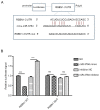MicroRNA‑378d inhibits Glut4 by targeting Rsbn1 in vitamin D deficient ovarian granulosa cells
- PMID: 33760197
- PMCID: PMC7985995
- DOI: 10.3892/mmr.2021.12008
MicroRNA‑378d inhibits Glut4 by targeting Rsbn1 in vitamin D deficient ovarian granulosa cells
Abstract
Vitamin D (VD) is not only associated with bone growth and development, but is also closely associated with numerous other pathological conditions. The present study aimed to investigate the effect of microRNA (miRNA/miR)‑378d on ovarian granulosa cells by regulating the round spermatid basic protein 1 (Rsbn1) in the absence of VD. The abnormal expression of miRNAs in ovarian tissues of the VD‑deficient mouse was analyzed using transcriptome sequencing. miR‑378d, glucose transporter 4 (Glut4) and aromatase (Cyp19a) expression levels were examined via reverse transcription‑quantitative (RT‑q)PCR and western blotting. The expression levels of Rsbn1, Glut4 and Cyp19a were detected in transfected mouse ovarian granulosa cells. The targeting regulation between miR‑378d and Rsbn1 was verified using double reporter gene assay and functional rescue experiments. Among the 672 miRNAs that were differentially expressed, cluster analysis revealed that 17 were significantly upregulated and 16 were significantly downregulated. Moreover, miR‑378d showed significant upregulation, which was further verified via RT‑qPCR. It was identified that the protein expression level of Rsbn1 was significantly downregulated. Furthermore, Glut4 mRNA expression was significantly decreased in the mimic group but markedly increased in the inhibitor group. By contrast, the mRNA expression levels of Rsbn1 and Cyp19a did not demonstrate any significant difference. The western blotting results indicated that the protein expression levels of Rsbn1 and Glut4 were decreased and increased, respectively, while Cyp19a did not show any significant change. In addition, the double reporter gene experiments confirmed that Rsbn1 was the target gene of miR‑378d. Collectively, the present results demonstrated that miR‑378d was abnormally overexpressed in the ovarian tissues of the VD‑deficient mice, and that miR‑378d could inhibit Glut4 production by targeting Rsbn1, which may lead to insulin resistance.
Keywords: microRNA‑378d; vitamin D; round spermatid basic protein 1; ovarian granulosa cells.
Conflict of interest statement
The authors declare that they have no competing interests
Figures





References
MeSH terms
Substances
LinkOut - more resources
Full Text Sources
Other Literature Sources
Medical
Molecular Biology Databases
Research Materials

